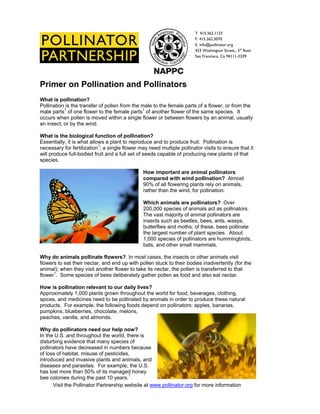
Polination
- 1. T. 415.362.1137 F. 415.362.3070 E. info@pollinator.org 423 Washington Street,. 5th floor San Francisco, Ca 94111-2339 Primer on Pollination and Pollinators What is pollination? Pollination is the transfer of pollen from the male to the female parts of a flower, or from the male parts1 of one flower to the female parts1 of another flower of the same species. It occurs when pollen is moved within a single flower or between flowers by an animal, usually an insect, or by the wind. What is the biological function of pollination? Essentially, it is what allows a plant to reproduce and to produce fruit. Pollination is necessary for fertilization1; a single flower may need multiple pollinator visits to ensure that it will produce full-bodied fruit and a full set of seeds capable of producing new plants of that species. How important are animal pollinators compared with wind pollination? Almost 90% of all flowering plants rely on animals, rather than the wind, for pollination. Which animals are pollinators? Over 200,000 species of animals act as pollinators. The vast majority of animal pollinators are insects such as beetles, bees, ants, wasps, butterflies and moths; of these, bees pollinate the largest number of plant species. About 1,000 species of pollinators are hummingbirds, bats, and other small mammals. Why do animals pollinate flowers? In most cases, the insects or other animals visit flowers to eat their nectar, and end up with pollen stuck to their bodies inadvertently (for the animal); when they visit another flower to take its nectar, the pollen is transferred to that 1 flower . Some species of bees deliberately gather pollen as food and also eat nectar. How is pollination relevant to our daily lives? Approximately 1,000 plants grown throughout the world for food, beverages, clothing, spices, and medicines need to be pollinated by animals in order to produce these natural products. For example, the following foods depend on pollinators: apples, bananas, pumpkins, blueberries, chocolate, melons, peaches, vanilla, and almonds. Why do pollinators need our help now? In the U.S. and throughout the world, there is disturbing evidence that many species of pollinators have decreased in numbers because of loss of habitat, misuse of pesticides, introduced and invasive plants and animals, and diseases and parasites. For example, the U.S. has lost more than 50% of its managed honey 1 bee colonies during the past 10 years. Visit the Pollinator Partnership website at www.pollinator.org for more information
- 2. Interesting facts about pollinators: • Bees can fly at about 7 miles per hour and have to beat their wings 190 times per second to do it! Bees are constantly on the lookout for bright-colored flowers with sweet scents. • Some kinds of bees, but not honey bees, pollinate flowers by their buzzing (vibrations), knocking the pollen loose from the anthers and onto the stigma. This is called "buzz pollination." • There are several thousand known species of native bees in the U.S. alone and more than 20,000 species worldwide; honey bees were originally imported to the U.S. from Europe, Africa, and Asia. • Butterflies and moths need a place to land on the flowers that they visit, so they prefer broad, flat flowers. Since they have long, straw-like mouthparts, they can suck nectar from deep within the flower. • Many beetle species eat pollen, so the plants they visit must produce ample amounts of pollen to make sure that there is enough left to pollinate the flower after the beetles are finished eating! • Hummingbirds have long beaks and brush-like tongues. They generally look out for long, tube-shaped flowers colored red or orange. • Nectar-eating bats, like moths, are attracted to pale or white flowers that blossom after dark. Websites for more information: • http://www.smithsonianeducation.org/educators/lesson_plans/partners_in_pollination/intro _4.html • http://www.scsc.k12.ar.us/1999outwest/members/GannK/monograph.htm Websites above and other sites geared to teachers are listed at: • http://www.thegateway.org/portal_seamarksearch/makesearch?past=keywords|pollinator| contains|yes||*&page=10 Join the Pollinator Partnership (P2) To find out more about pollinators, sign up for the Pollinator Listserv, or download a free ecoregional guide on how to plant for pollinators, go to the Pollinator Partnership website at www.pollinator.org to “Getting Involved.” 1 The anther produces the pollen; this, together with the filament, make up the stamen, the male reproductive organ of a flowering plant. [Mnemonic – stamens are male because they "stay men.”] 1 The stigma sits on top of a style, or stalk, which leads to an ovary at the base; together, these make up the pistil, the female reproductive organ of a flowering plant. 1 When pollen grains are transferred onto a stigma, the pollen grain grows a tiny pollen tube down the style and into the egg-filled ovary. Eventually, the pollen and the egg combine to form a seed. 1 Animal pollinators carry the pollen in different ways. Vertebrates such as birds or bats carry pollen in their feathers or hair. Invertebrates such as bees and butterflies lack hair, but have bristles on their legs, head, and other body parts. Honeybees have tiny baskets on their legs for carrying pollen back to the hive. When butterflies use their long proboscis, or nectar-gathering appendage, to sip nectar from tubular flowers, they get peppered involuntarily with pollen on the proboscis or the head. 1 While honey bees aren't native to the U.S., they are extremely important pollinators here, with many colonies managed by professional beekeepers. The main threats to honey bees are mites and misuse of pesticides. Visit the Pollinator Partnership website at www.pollinator.org for more information
